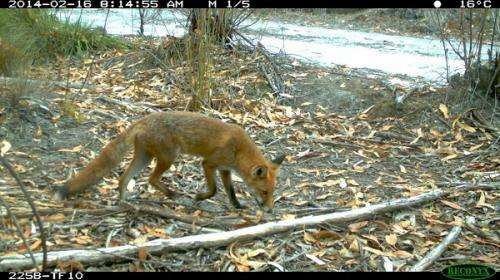Fox baiting regime may miss the mark

(Phys.org) —A Murdoch University ecologist says it is not clear how effective traditional fox (Vulpes vulpes) poisoning is, as many baits may be taken by foxes but not eaten; or consumed by other animals.
The researchers studied fox carcasses at "Red Card for Foxes and Rabbits", an annual community culling exercise involving land owners and shooters who then bring the carcasses to a central location for study.
Murdoch Post Doctoral Fellow Shannon Dundas had previously used 'Red Card' carcasses for other studies, and she saw the event as an opportunity to assess several bait delivery modes.
"We found that there was quite a large uptake by non-target species," Dr Dundas says.
"If we are looking to alter the way baits are presented to reduce non-target uptake, we also need to know that foxes are willing to take them," she says.
Her team visited properties at Darkan, in the Wheatbelt; and Mount Barker in the Great Southern, placing non-toxic baits and cameras to monitor some of them.
Dr Dundas says they prepared the baits, which were standard-sized dried kangaroo meat used by the Department of Parks and Wildlife and the Department of Food and Agriculture, in four different ways.
Some they simply placed on the ground, following the usual practice.
Others were wrapped in Kangaroo hide.
They suspended a third set of baits from transoms using nylon fishing line, and buried the rest to see if animals would dig them up.
They injected each set of baits with a different chemical marker known to be readily incorporated into the living tissues of animals that eat them.
These were Rhodamine B and Rhodamine 6G, Tetracycline which binds to calcium in the teeth and Iophenoxic acid, which can be detected in the blood.
"The baits are not toxic but have different fluorescent markers placed in them," Dr Dundas says.
When property owners brought the carcasses in, five weeks later, she sampled parts of each animal for analysis.
"We decreased it down to taking a snout which gives us the canines as well as the whiskers and a bone sample, plus we took blood in the field," she says.
At the time of publication Dr Dundas says she has almost completed analysing data from the cameras, and early indications are that the foxes prefer the baits wrapped in Kangaroo skin, or simply laid loose on the ground, over buried and suspended baits.
She will now begin analysing the snouts to see if the foxes actually ate them.
Provided by Science Network WA



















